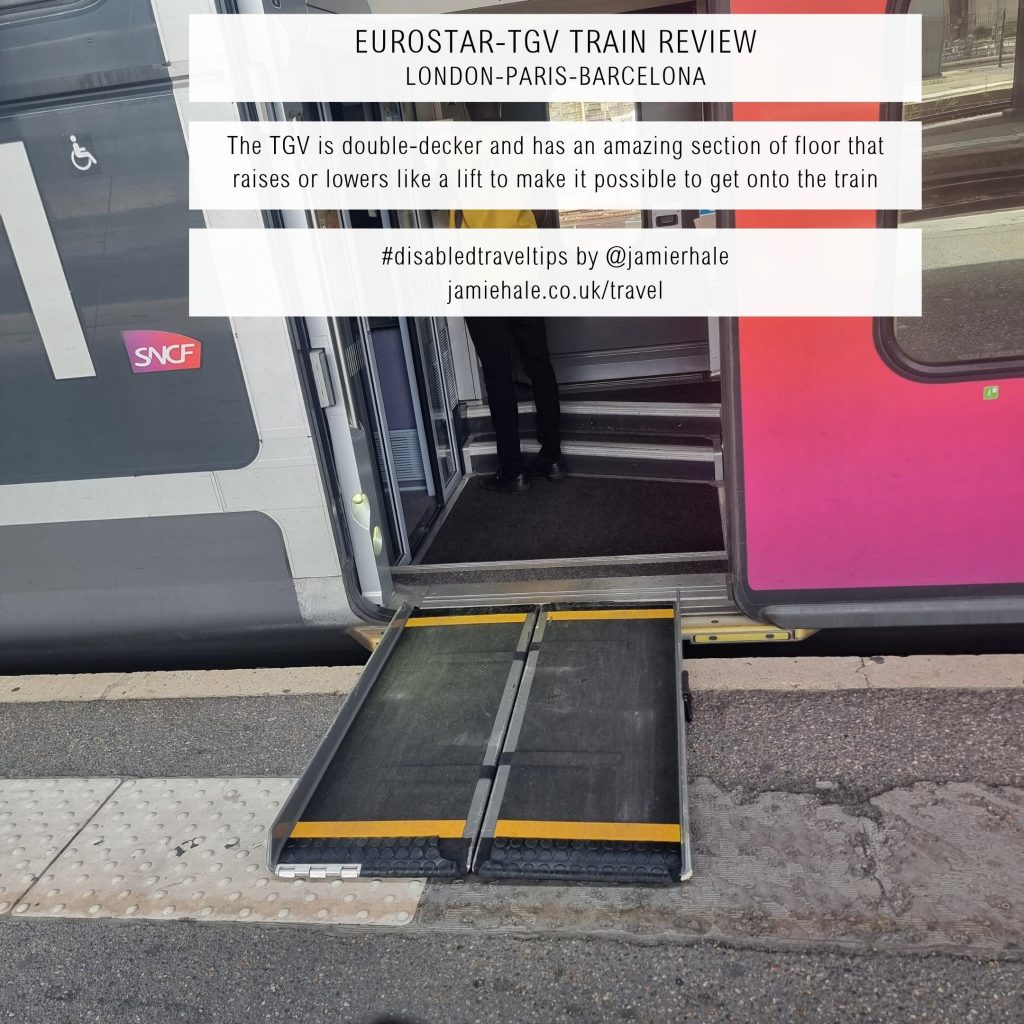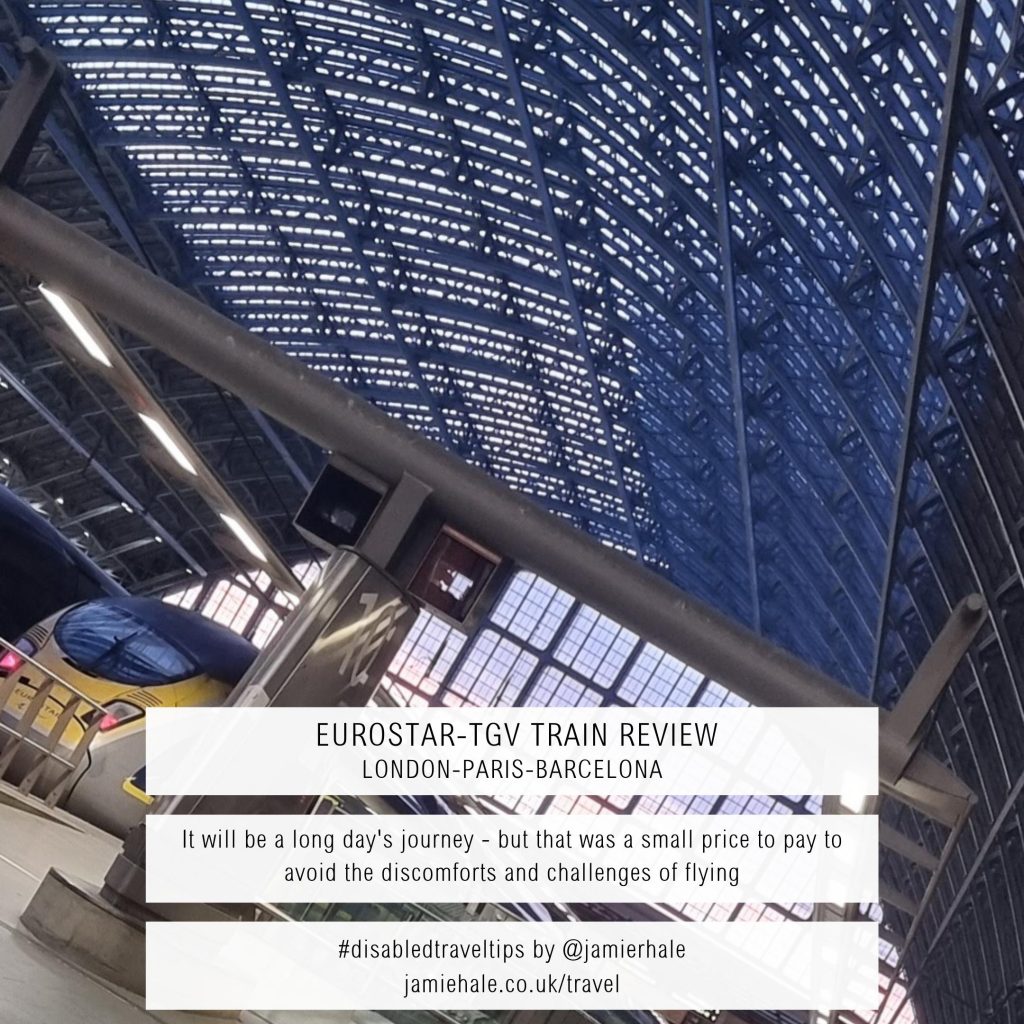When I go to Spain, I usually fly. However, it seems to be the summer of chaos with cancelled flights, and a series of issues with assistance for disabled passengers. Given that, I was very glad I’d decided to go from London to Barcelona by train.
This also had the advantage of not risking my chair in the hold of the aeroplane. There are so many nightmarish stories of people having their wheelchairs broken when flying. I’ve had chairs be damaged, but not broken thankfully. If that had happened to mine, it would have been very hard for me to continue my trip, so the train seemed sensible.






London to Barcelona by train
The train sounded like it would be quite arduous at the outset. Home to St Pancras, St Pancras to Gare du Nord, an hour on foot to Gare de Lyon, then the TGV to Barcelona. A very long day. However, when you fly, you lose a whole day to airports anyway. Once I realised that, staying comfortably in my own chair for the day sounded far more tempting.
I thought this route would be far more expensive than flying. However, once I considered baggage costs, this wasn’t the case – London to Barcelona by train was surprisingly affordable. The Eurostar to Paris is very cost-effective for disabled people. It costs about £80 each way for me and a companion. From Paris to Barcelona was more expensive, but overall it came to a similar price to flying. It also meant I would arrive in the heart of the city, rather than an airport on the outskirts.
You can travel the route from London to Barcelona by train (or back) in a day. On the way out, I spread it across two days. I was very worried about a train being very delayed or cancelled. This would have stranded me in Paris without proper care. On the way back, I decided to do it in one day. I was very nervous about this working out – but it was actually fine. There are two high-speed trains each day between Barcelona and Paris I believe,. With the Eurostar combinations open to us, there were about 4 hours between trains, which was plenty of time.
Eurostar
Because the Eurostar is international, you will have to go through passport control to travel. Your luggage will need to go through a scanner, and there are lots of rules about moving various food products in and out of the EU. Luckily I’ve never had any issues at Eurostar security (even when I was carrying about 40 used needles). Unlike when flying, you’re also able to bring as many liquids as you want. Security does take time though, so make sure you allow enough time to do this.
Getting through security
As a wheelchair user who books the Standard Premier space, you have access to the business lounge. At London St Pancras this works well – staff will take you through security, then will drop you off there, and collect you for your train.
At Paris Gare du Nord this works somewhat less well. Whether the staff give you assistance through security seems patchy. You also have to meet the ramp on the platform – nobody will come and get you. If you wait until they announce your train, you will have difficulty fighting your way through the crowds. I’ve found it’s best to leave the business premiere lounge about 40 minutes before departure and going to the priority seating area at Gate B. This gives me a better chance at parking in the wheelchair space before people have filled it with their luggage.
Eurostar access
The Eurostar has two models of train it runs regularly, as I understand it. The newer model trains are more spacious and have a good size of adapted toilet. The older ones… let’s just say that I didn’t manage to fit into the toilet with the door closed.
Getting on and off the Eurostar, you either use a very long ramp, or a combined ramp-lift system. This can involve quite a tight turn, but it’s manageable if your chair is reasonably manoeuvrable.
Crossing Paris – finding the station
The challenge with this route is that the Eurostar uses Gare du Nord, and the Barcelona TGV train uses Gare de Lyon. They’re a short (inaccessible) metro apart, 15 minutes taxi journey, about half an hour by bus, or about an hour’s wheel.
Not all taxis are accessible, and when I tried to book an accessible one there weren’t any. I eventually decided it was fastest just to wheel between the stations. If you’re trying to do the whole trip in a day, pre-book an accessible cab. This will help make sure that it will meet you and get you where you need to be.
With a four hour gap between trains, there is enough time to cross Paris – but probably not to do any sightseeing!
The TGV to Barcelona
The train from Gare du Lyon to Barcelona is within the EU and Schengen. This means that there’s no mandatory passport control. When I travelled Paris-Barcelona I didn’t have to even get my luggage scanned, though I did Barcelona-Paris.
Frustratingly, for some unknown reason, Paris and Barcelona stations don’t communicate properly. This means having a ramp booked to get onto the train doesn’t mean having a ramp booked to get off the train. When you arrive at Barcelona, it’s worth going to the assisted travel reception to make sure you have booked your ramp for the journey home.
Getting onto the train
These trains carry two wheelchairs, but space is very tight if they’re both bigger chairs or scooters. Because the trains are double-decker, with the wheelchair spaces on a lower deck, they look alarming at first sight. There are stairs down inside the train to the wheelchair space. However – don’t panic. The floor rises up to make a flat level, then lowers itself again, like a small lift. You still need a short ramp to get onto the train, but then you’re on the floor-lift – a wonderful invention.
Another thing that’s tight is the toilet. This one I could get into, but only just. Had I needed to transfer, there would have been no space for anyone to help me. However, there would have been no space to fall either! On my way back, sharing the wheelchair space with a large scooter, and with the train full of luggage, I don’t know how I would have gotten to the toilet if I needed it.
Doing the journey in a day certainly meant a long day – I was up at 05:30, and in bed at about 23:30. However, it was a restful day, in the comfort of my chair – which felt very worthwhile as a decision.